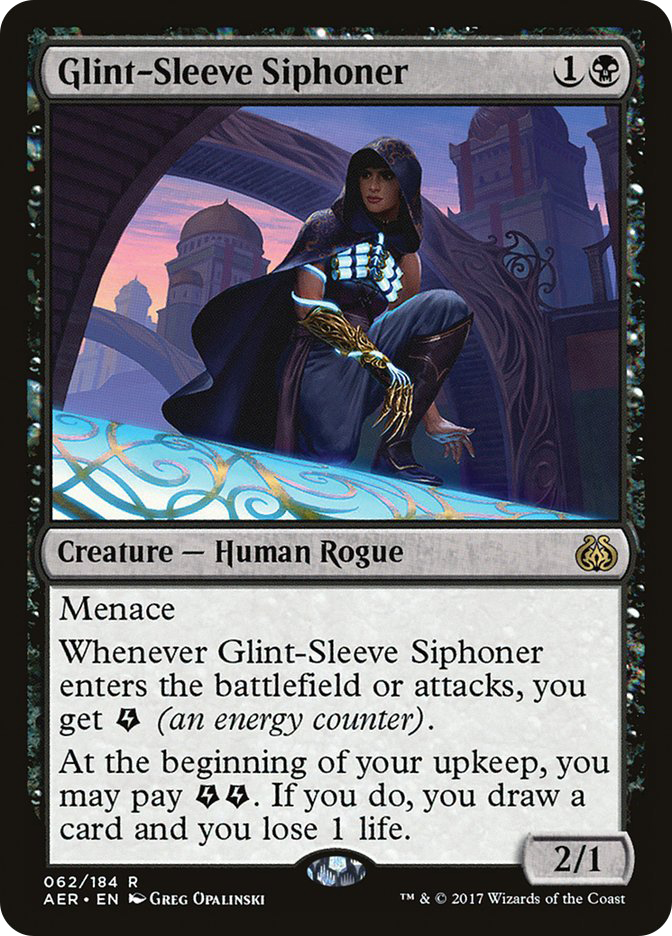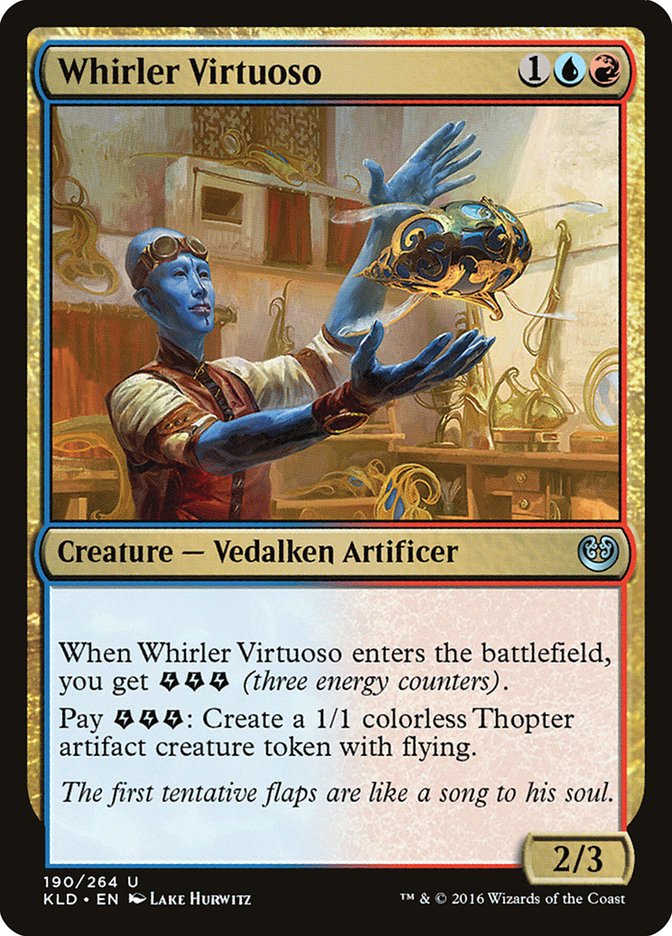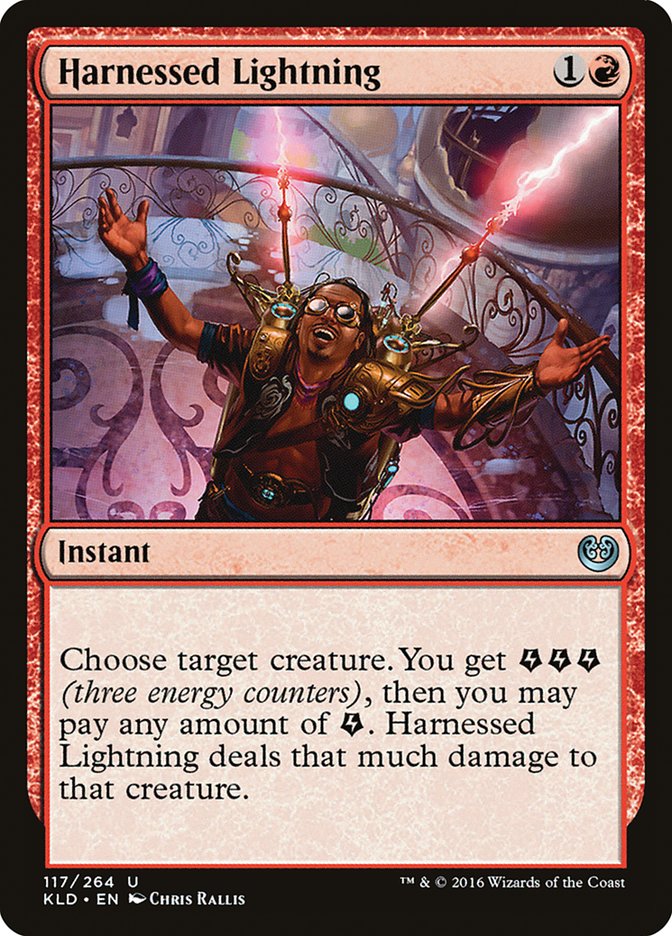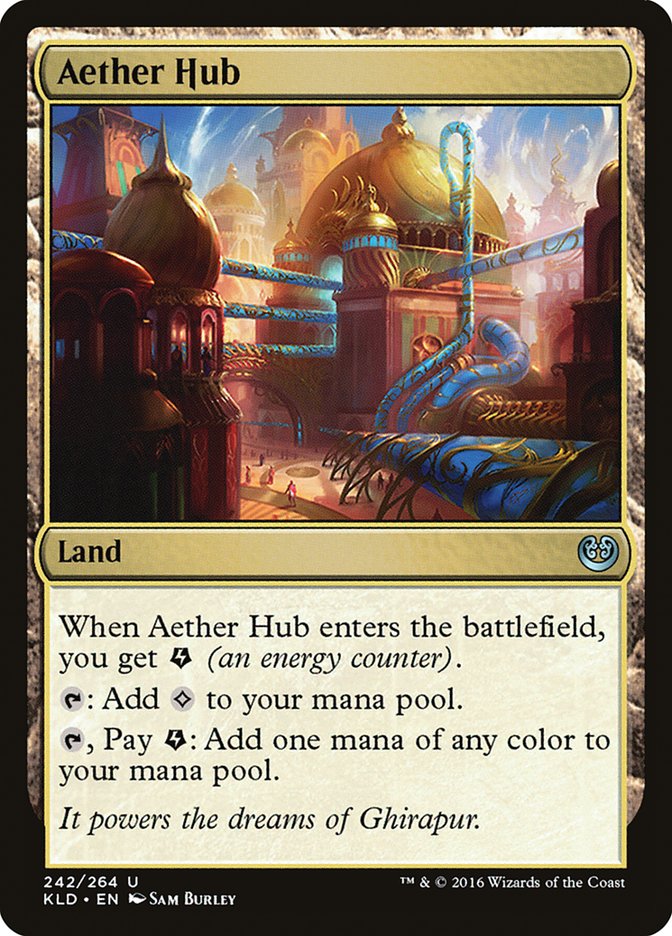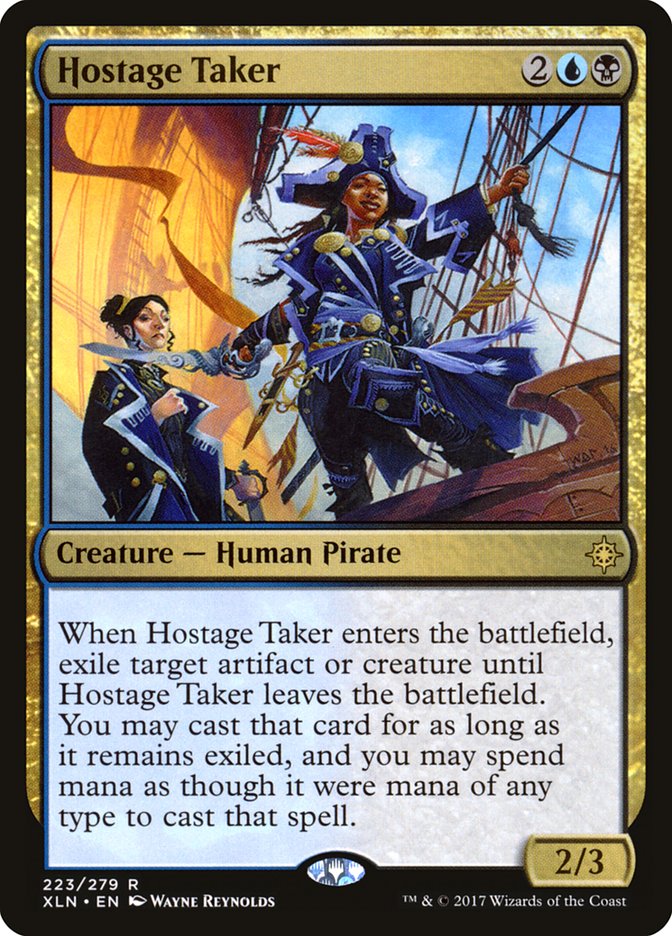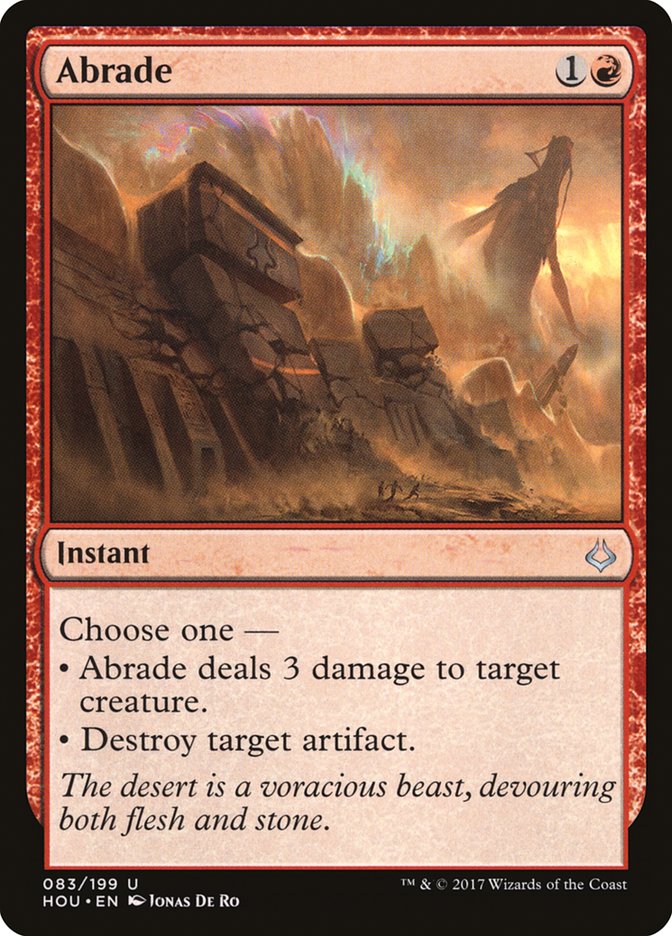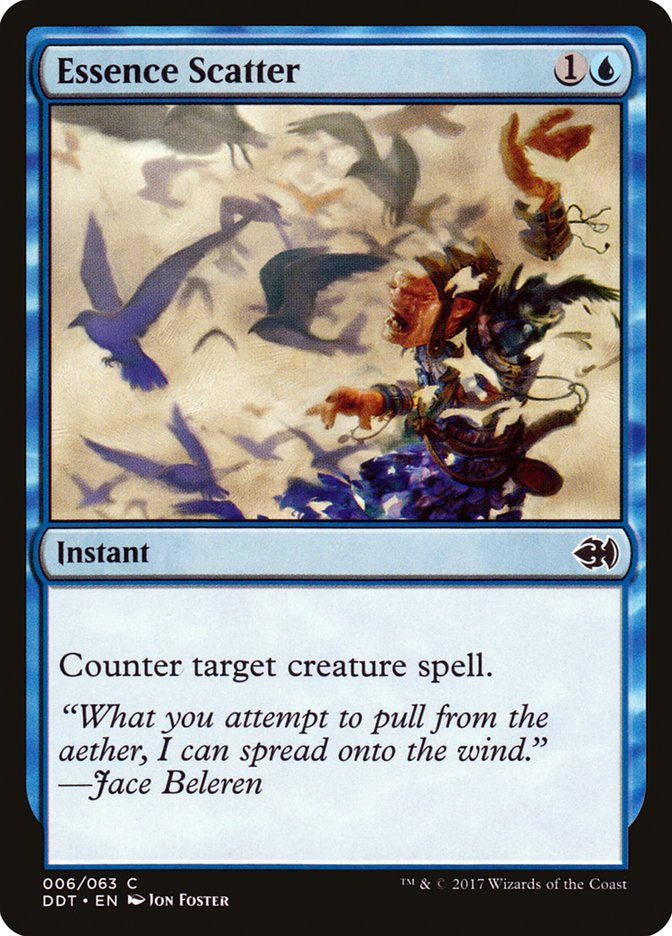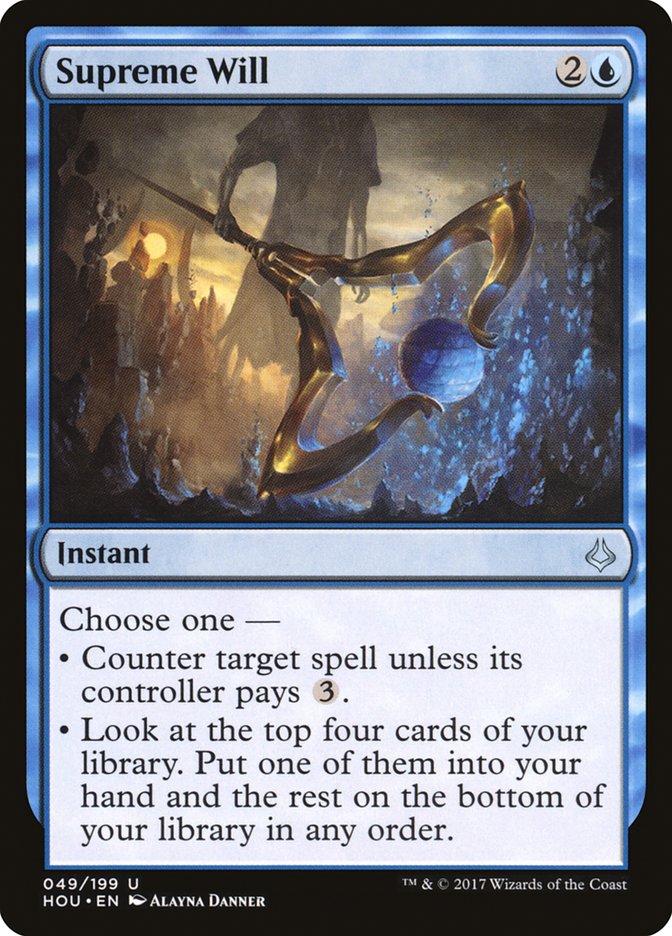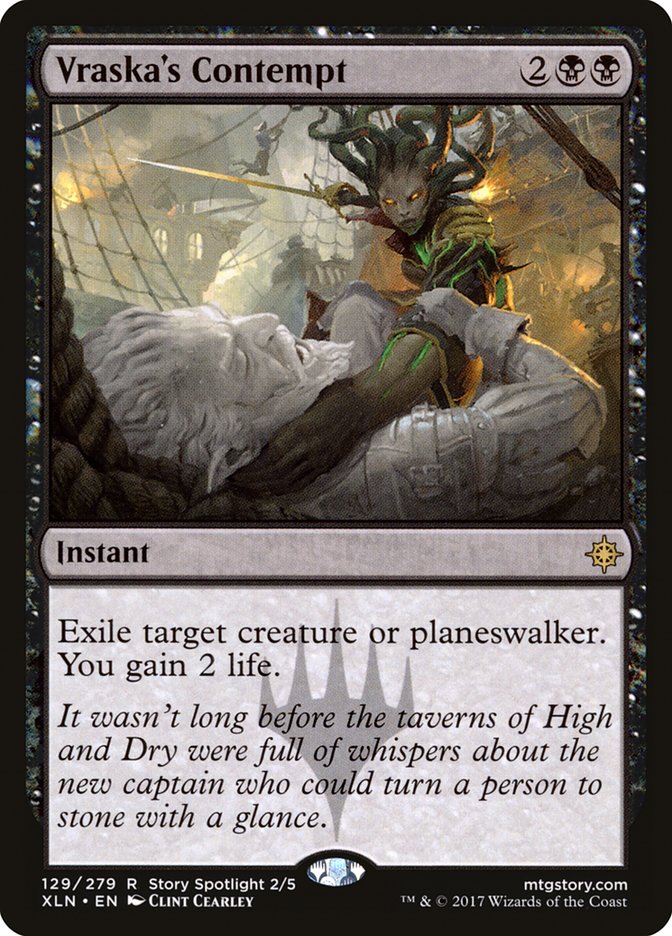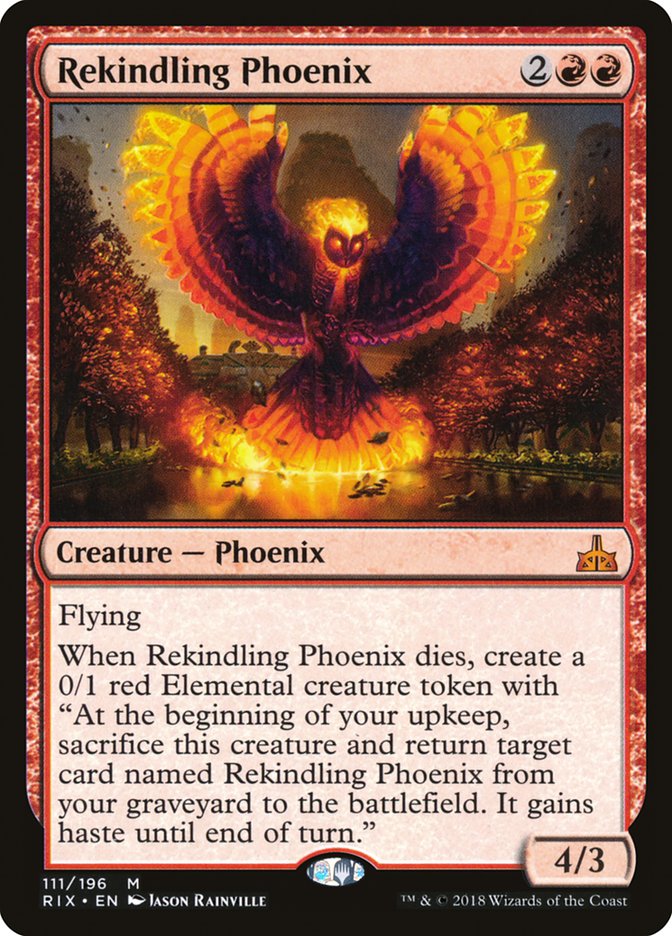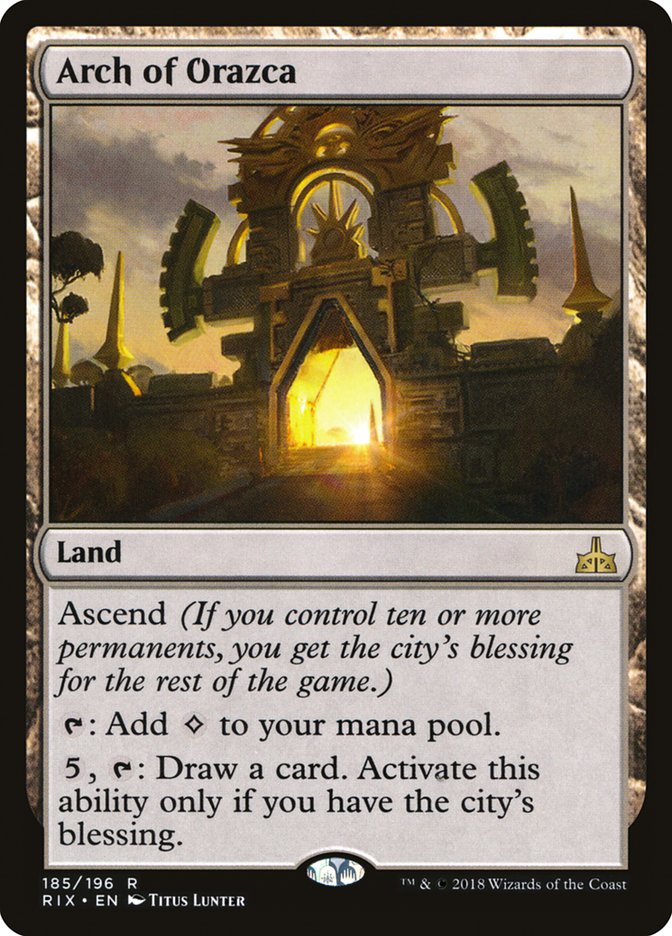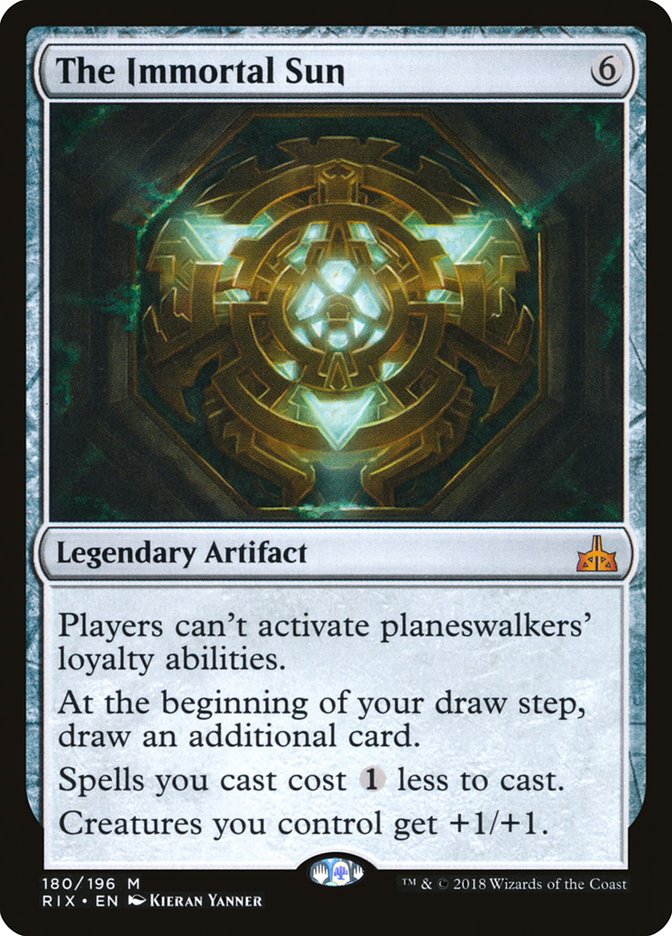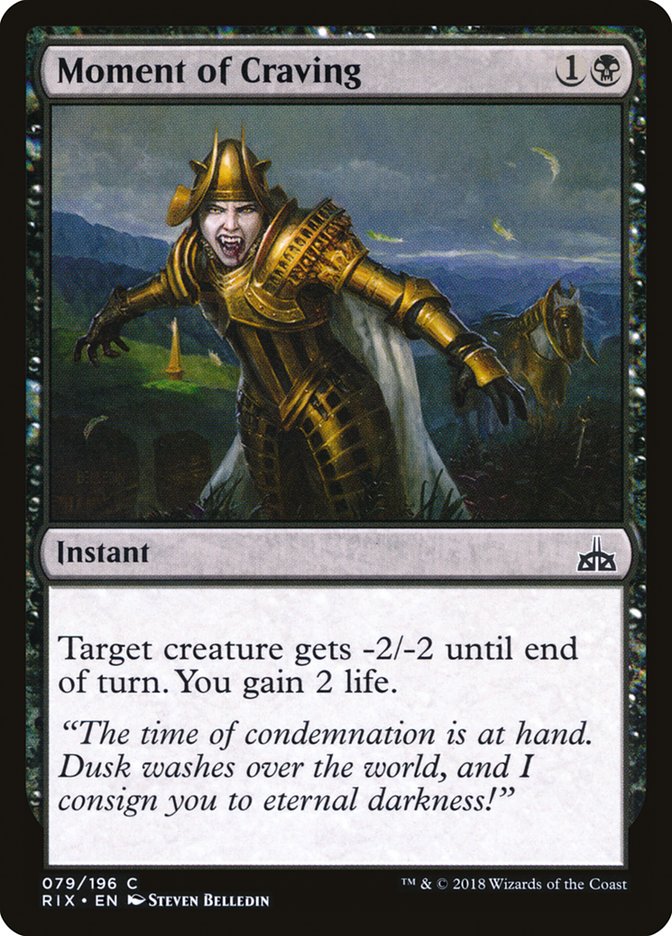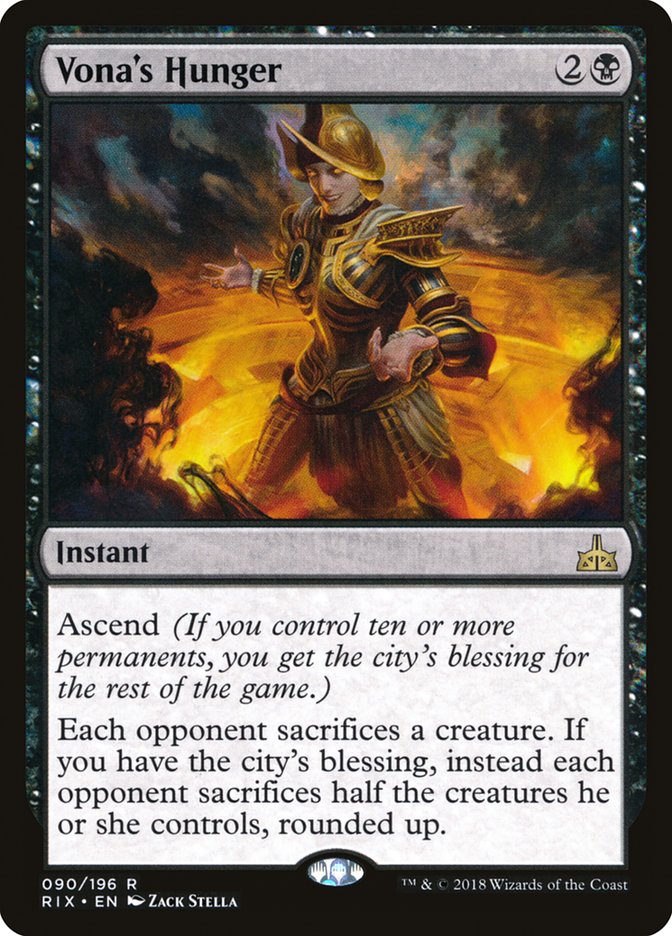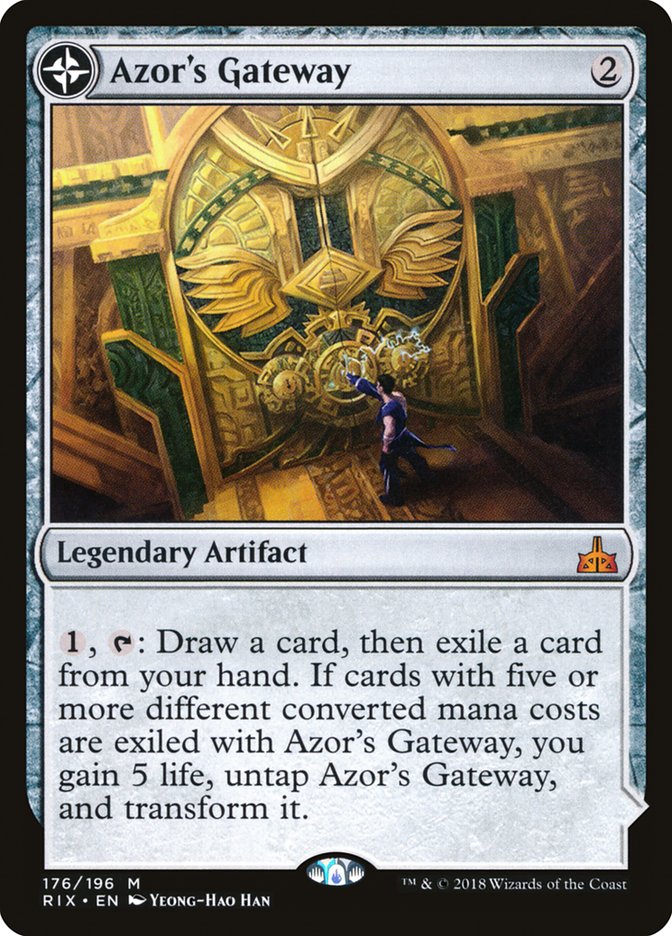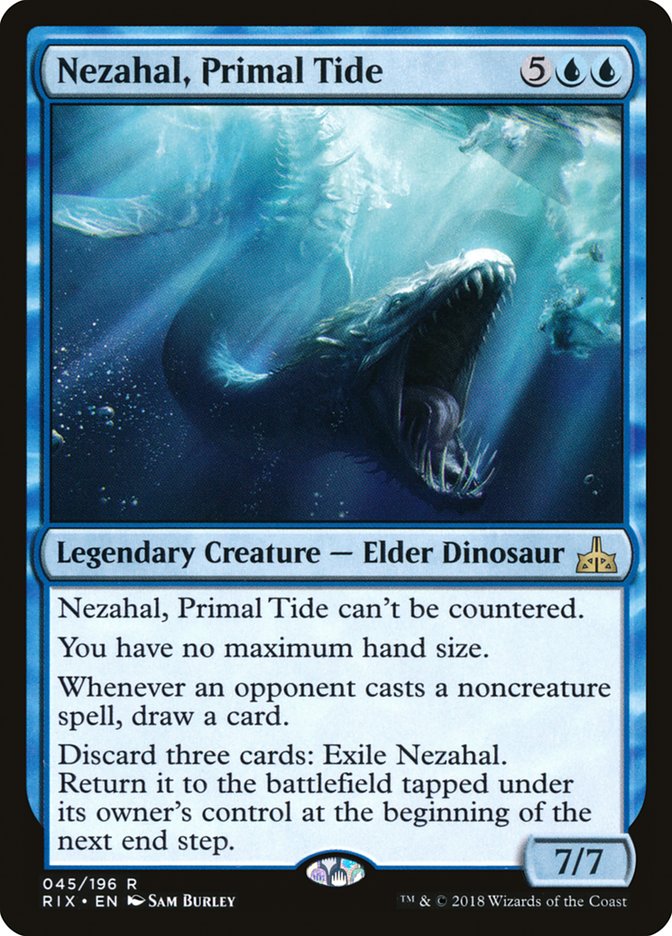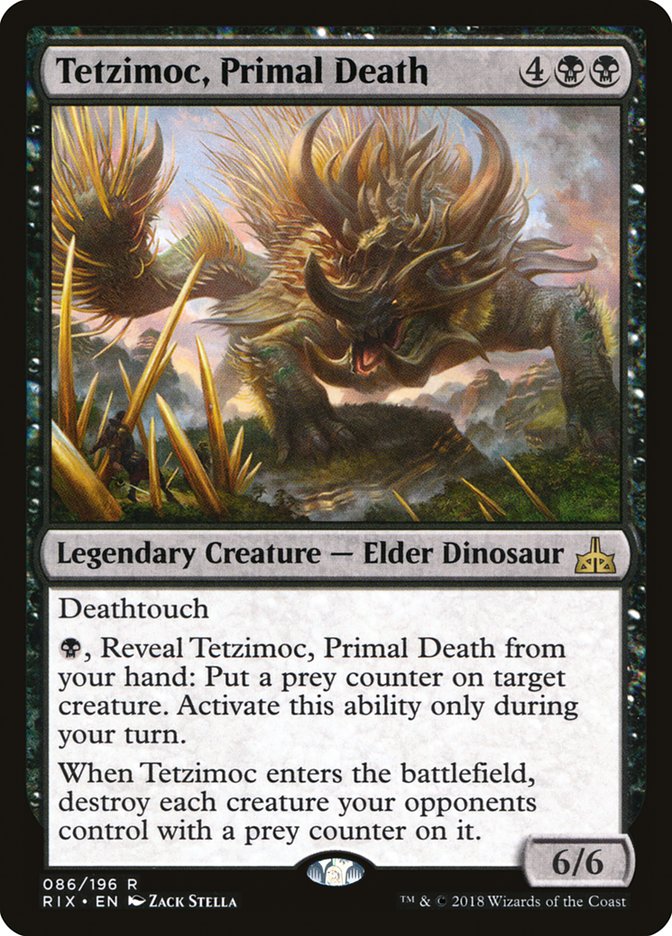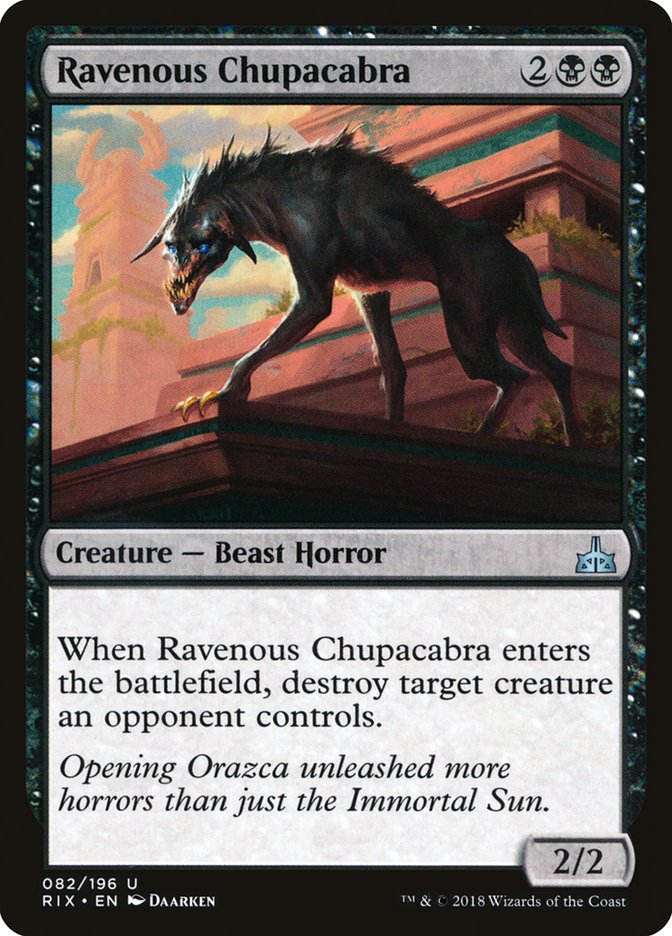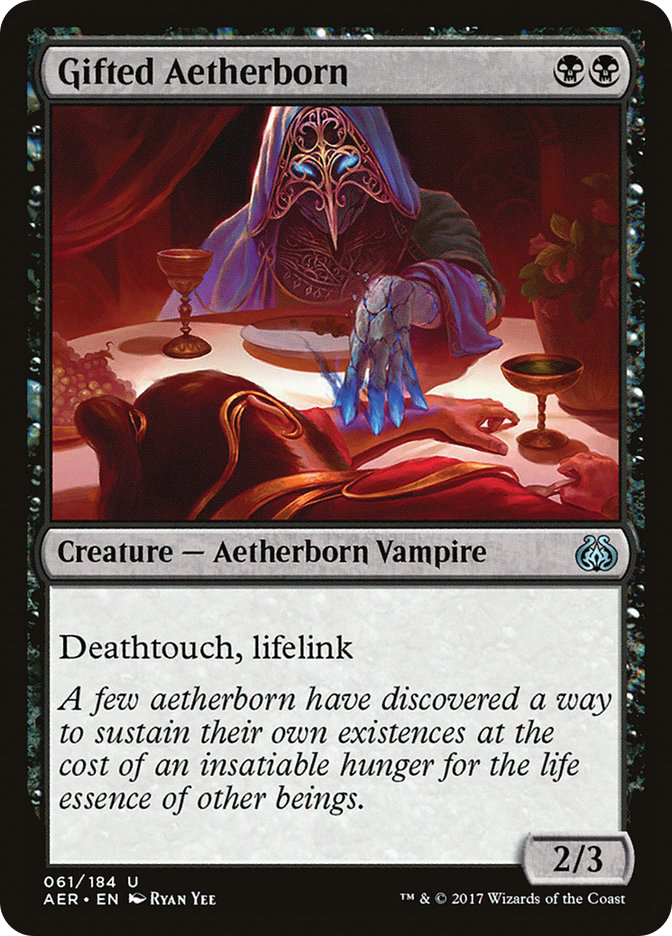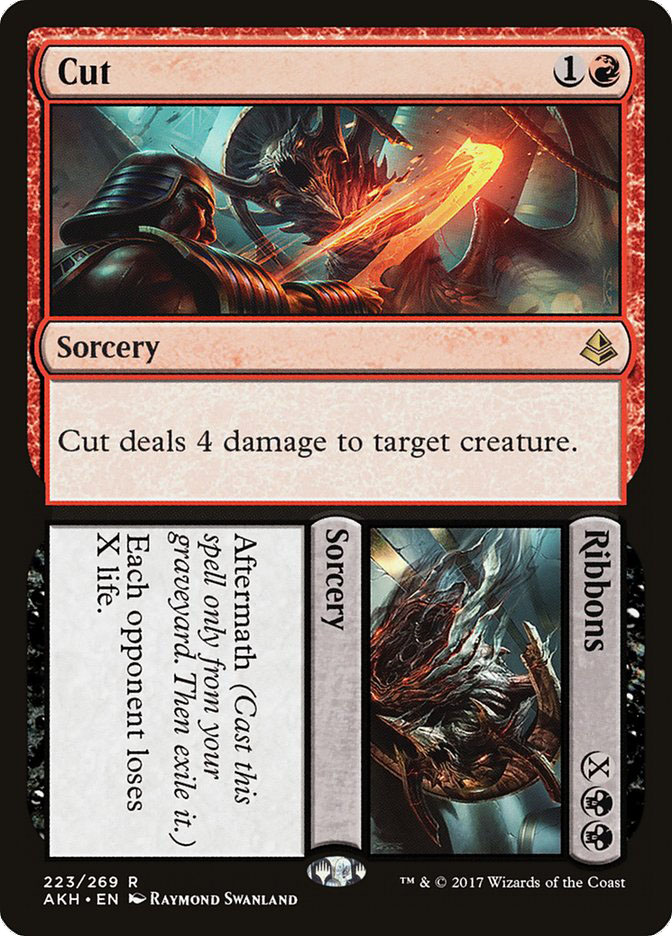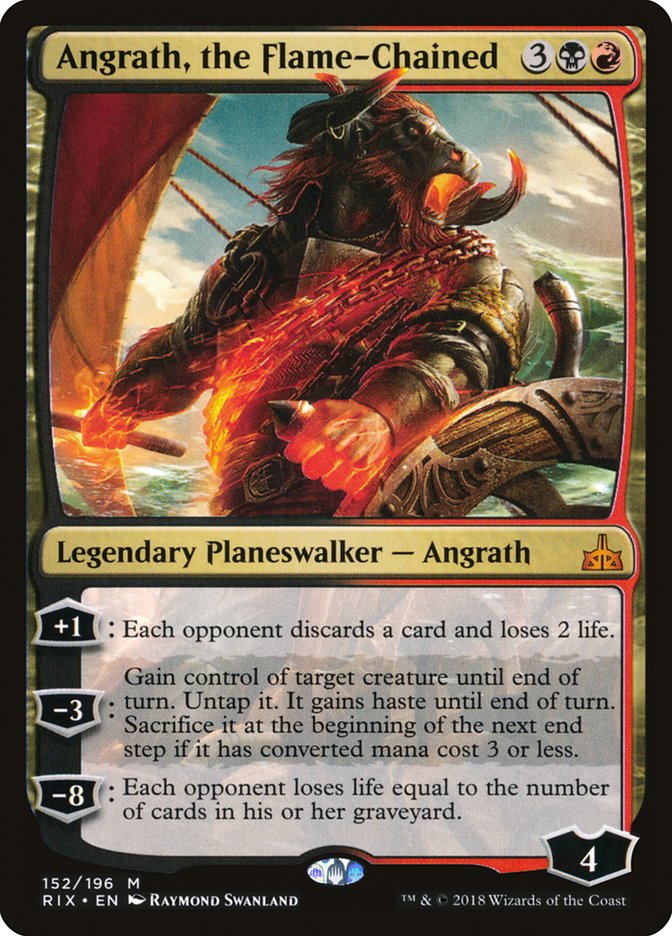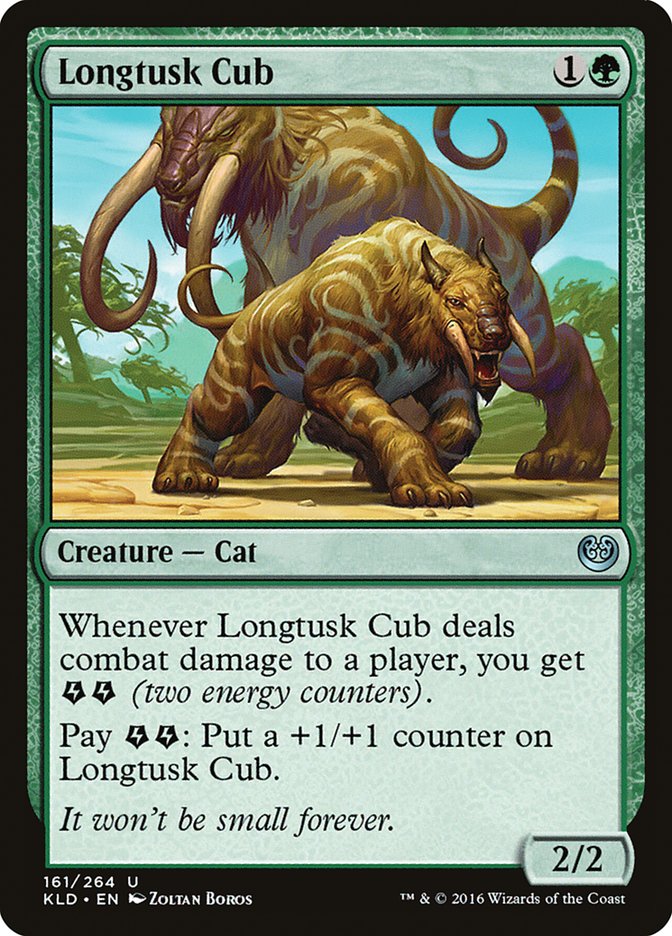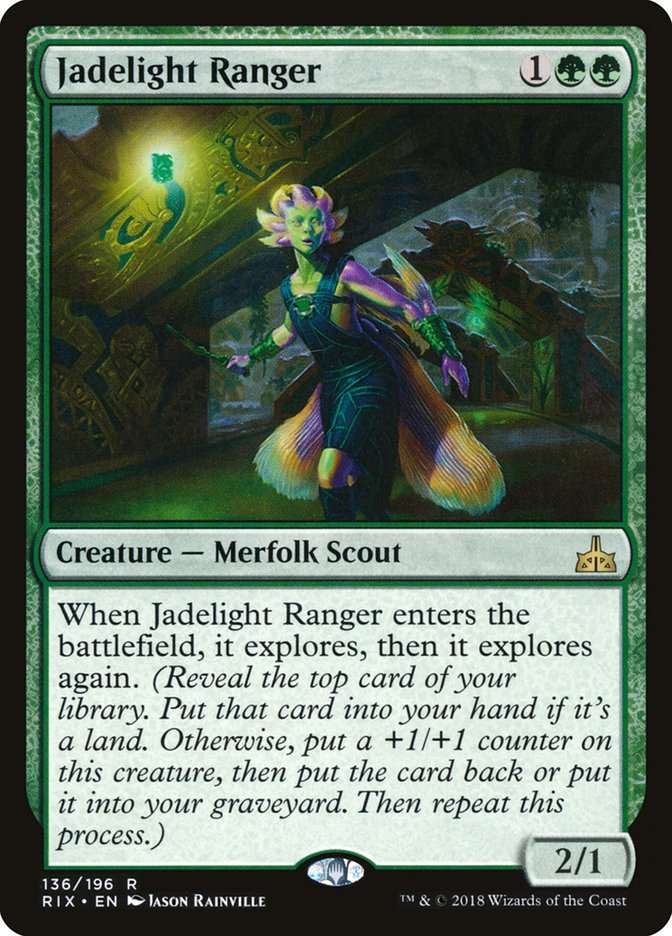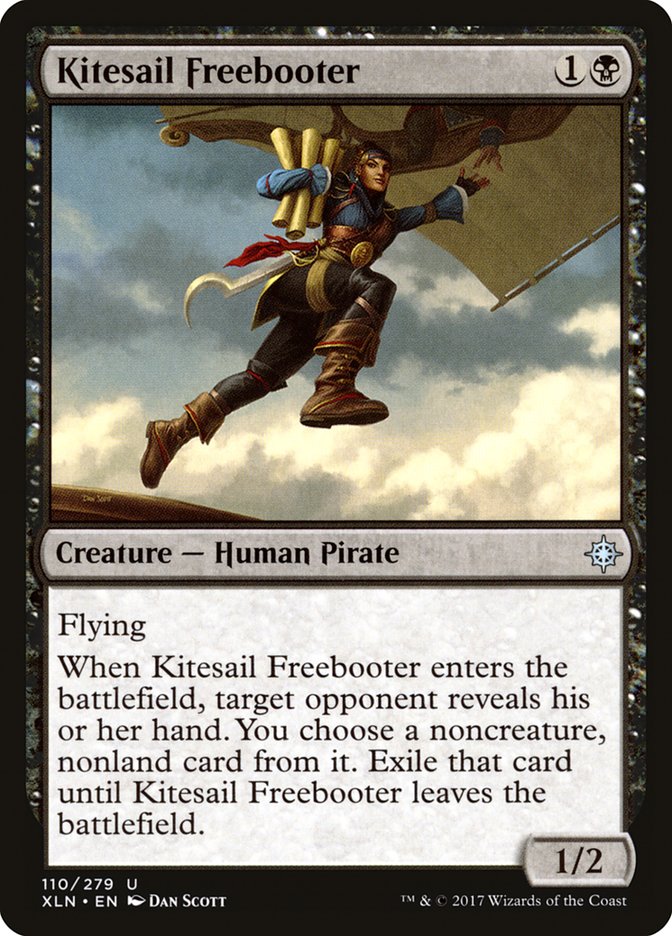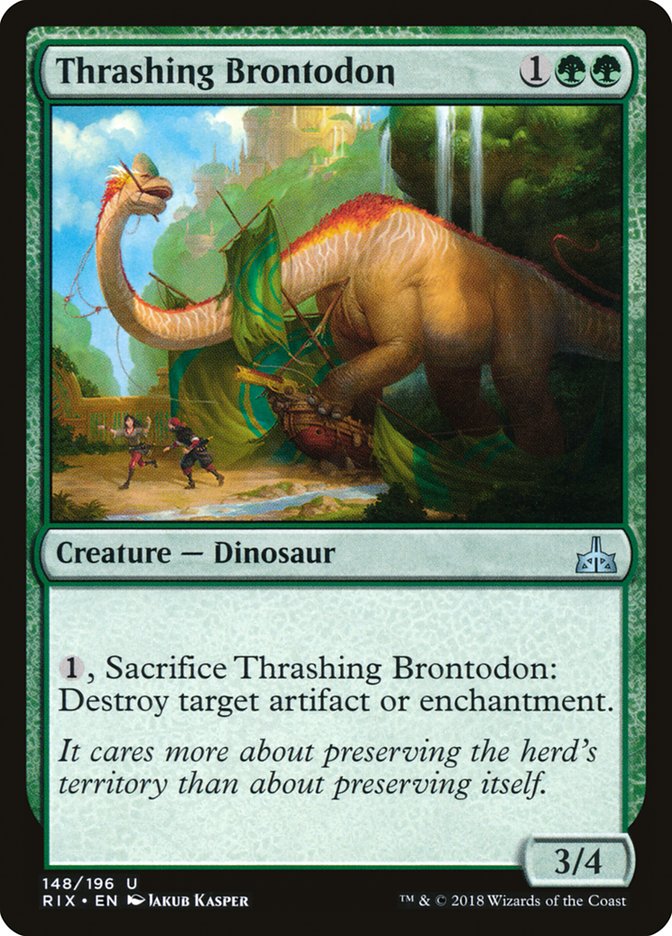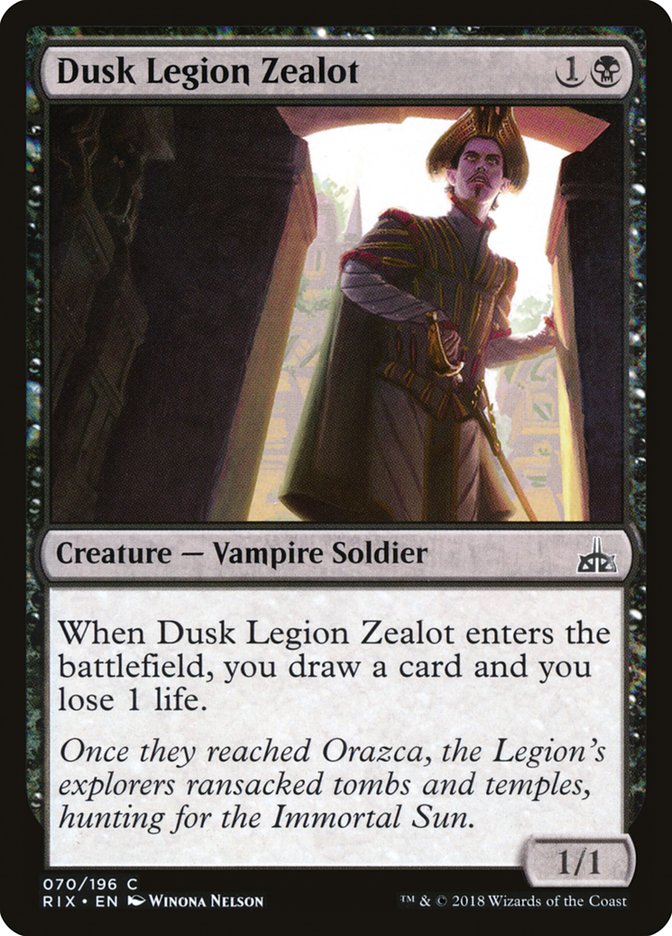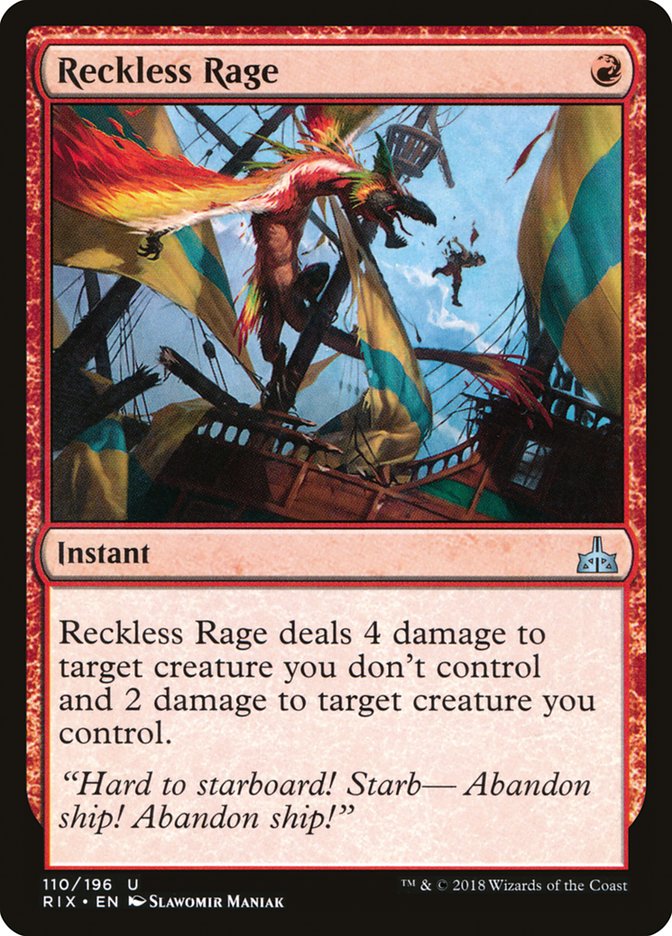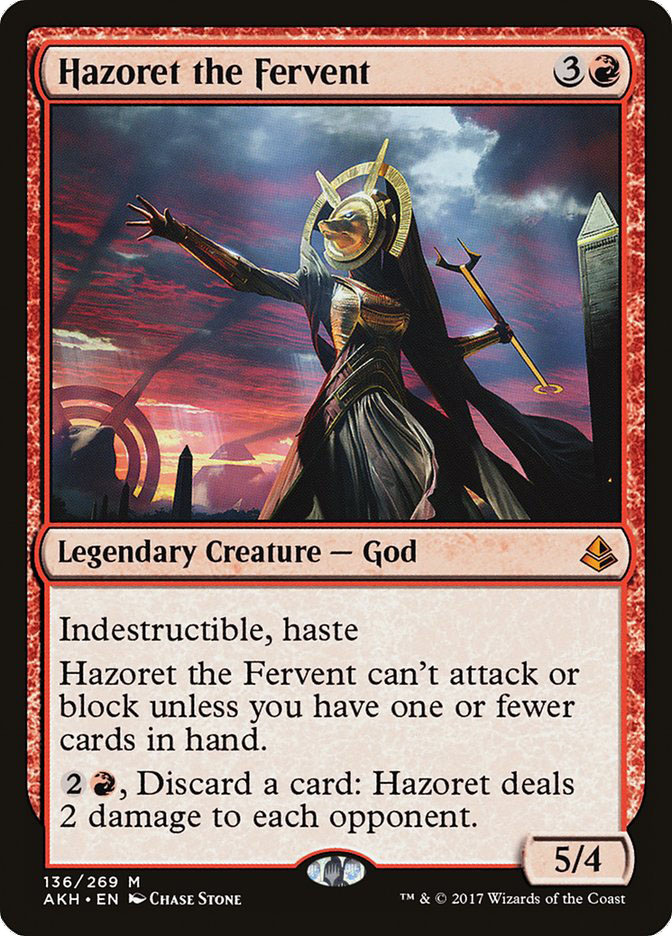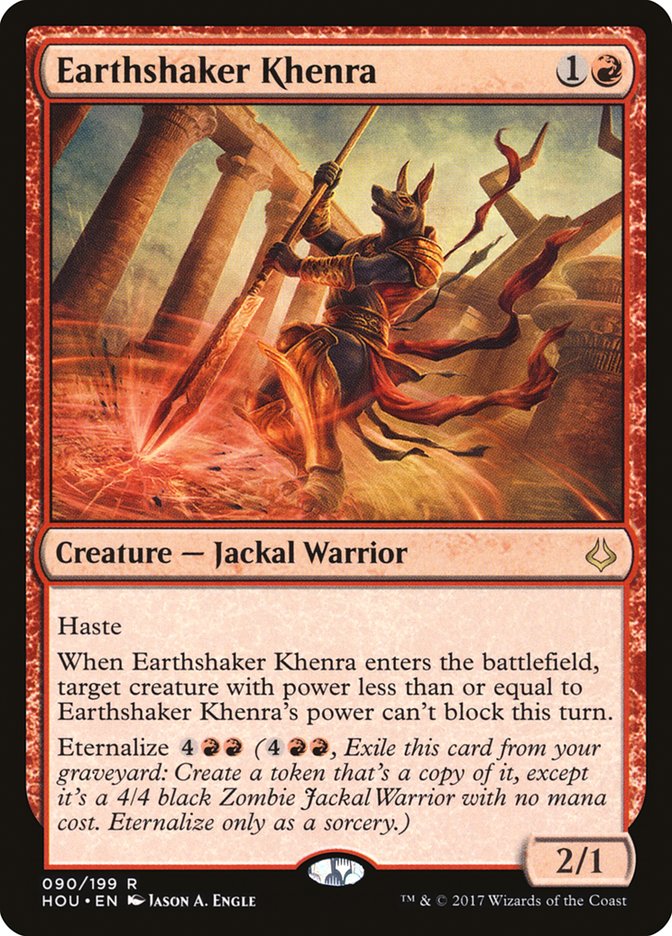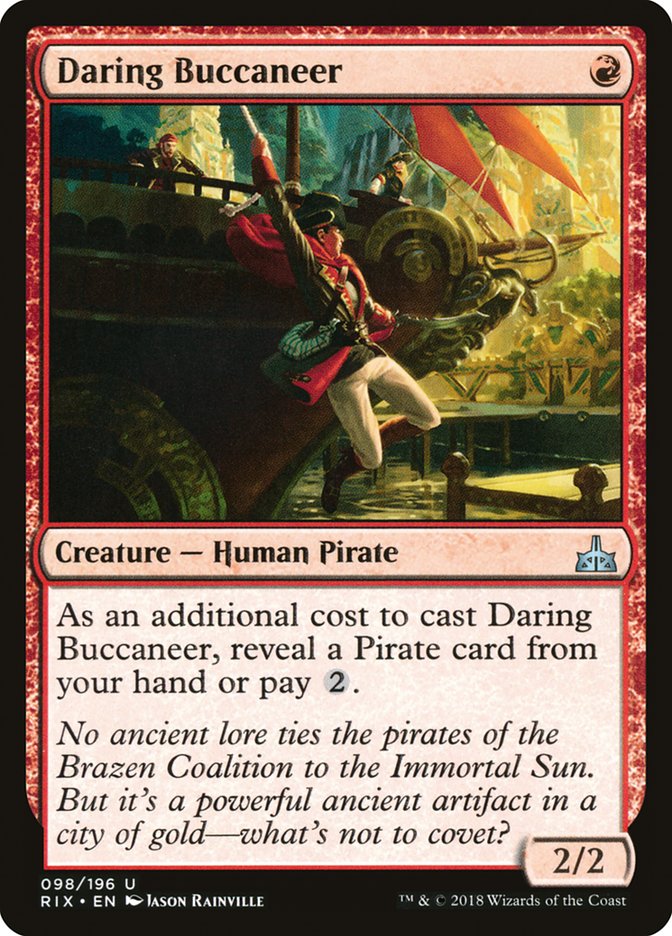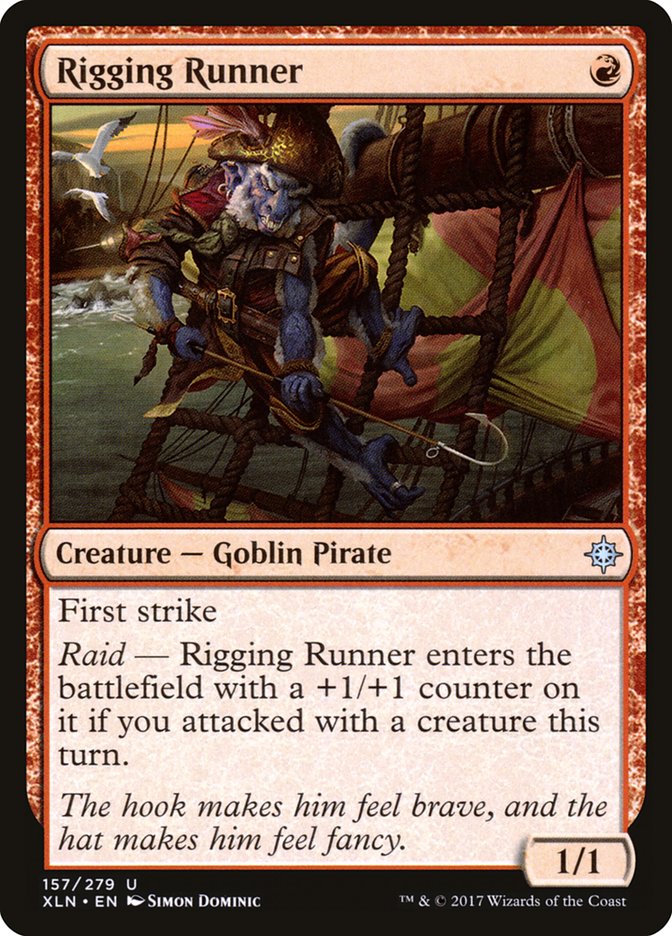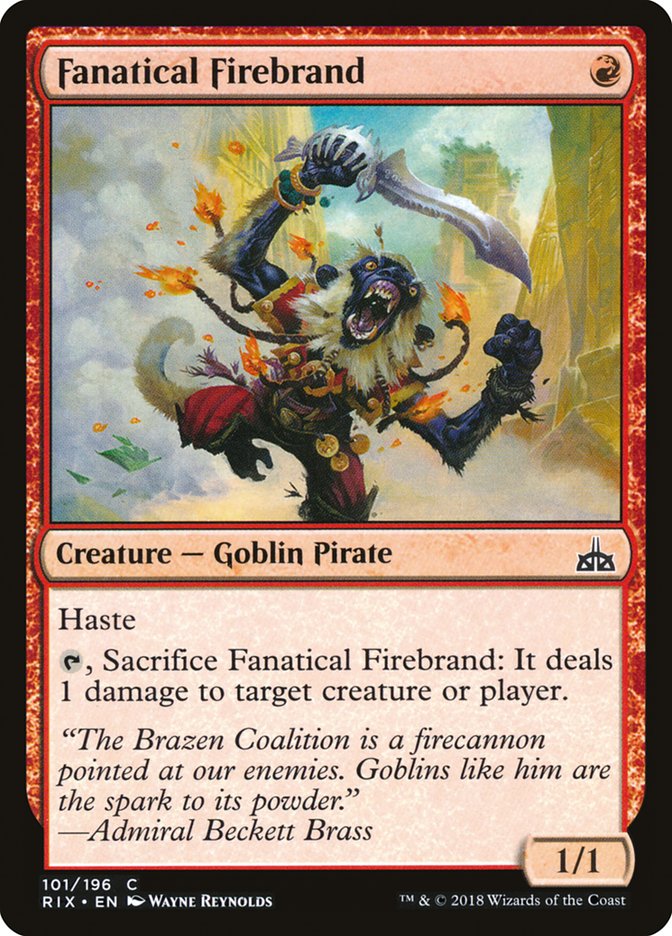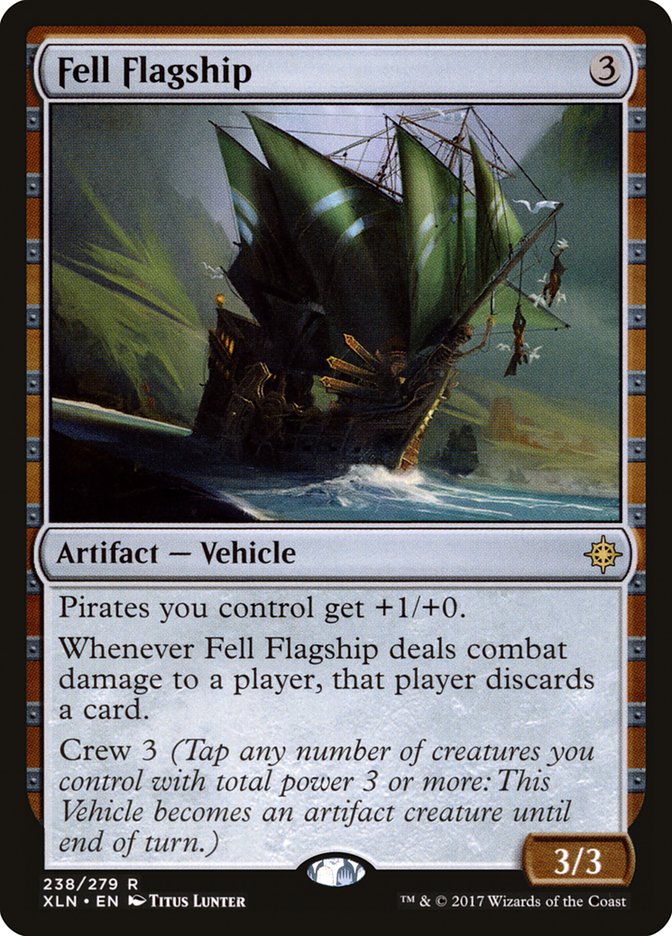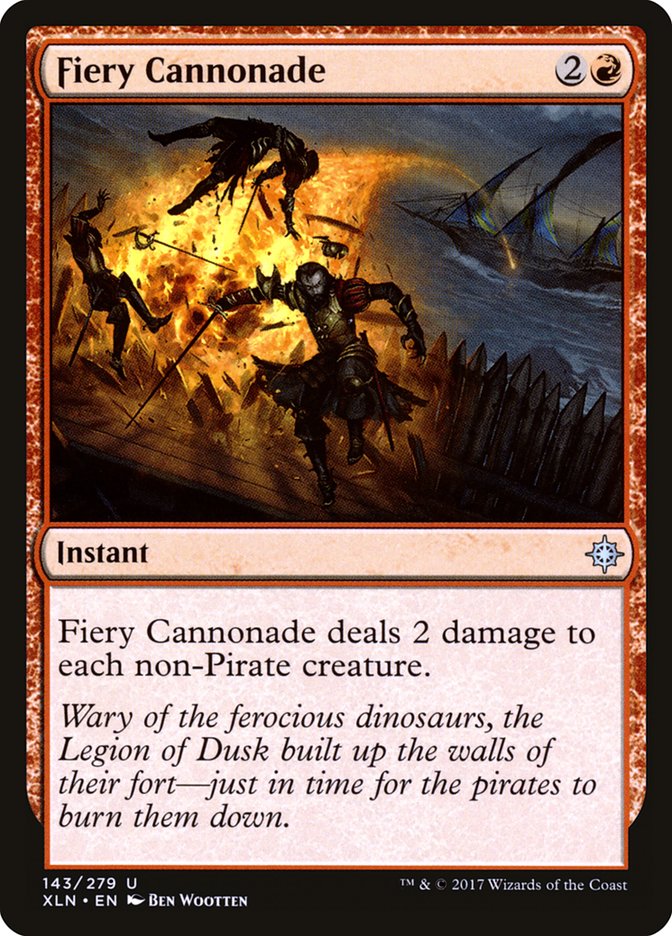It would appear that Rivals of Ixalan has brought along with it
one of the bluntest measures for mixing up the metagame there is.

Bans.
While nobody’s surprised to see Attune with Aether or Rogue Refiner banned,
and Ramunap Ruins makes sense in context, it is surely Rampaging Ferocidon
that sticks out as odd.
While my thoughts on the banned/restricted list changes can be found
here
, my focus today is on diving headfirst into the new format. A new set and
a whole new context, thanks to the biggest Standard banned list upheaval in
15 years, means there’s a lot to figure out.
Where to start?
Honestly, the first strategy that popped into my head looks to build around
the synergy of these four cards:
We could build a deck that takes advantage of how all these cards are good
enough on their own but get added value out of our ability to convert
energy at will at no cost. For instance, what about starting with something
like this?
Creatures (18)
- 2 Torrential Gearhulk
- 4 Whirler Virtuoso
- 4 Glint-Sleeve Siphoner
- 4 Glorybringer
- 2 The Scarab God
- 2 Hostage Taker
Planeswalkers (2)
Lands (26)
Spells (14)

Yes, despite the banning of Attune with Aether and Rogue Refiner, I think
it’s very likely that one or more Energy decks will be among the best in
the format. What colors to play remains to be seen, but my thinking with
Grixis is that Attune with Aether and Rogue Refiner are specifically a nerf
to green Energy cards. There are a lot of good Grixis Energy cards, and
Grixis Energy wasn’t that much worse than Temur Energy to begin
with. What’s more, we no longer have to worry about Ramunap Ruins!
Another big draw to Grixis is the card quality. Chandra, Hostage Taker,
Glorybringer, The Scarab God, and Torrential Gearhulk are many of the
absolute best cards in the format, and we get to play with all of them. And
it’s not like the aforementioned Glint-Sleeve Siphoner, Whirler Virtuoso,
and Harnessed Lightning are low on the list either.
This deck is nearly all platinum hits.
When the “weakest” spells in your deck are Supreme Will, Vraska’s Contempt,
and Essence Scatter, you’re generally going to be ahead of most opponents
on card quality.
The real weakness of this deck, of course, is the manabase. It’s not that
it’s “bad” per se. It’s just going to involve a fair bit more lands
entering the battlefield tapped than most, which can be a tempo hit,
especially with how many fours, fives, and sixes we aspire to run.
What about cutting a color?
So, here’s the problem: If you cut a color, you’re necessarily losing
either Glint-Sleeve Siphoner or Whirler Virtuoso, and at that point, are
you really even an energy deck?
We don’t need to be, of course; but the cutting either of Glint-Sleeve
Siphoner or Whirler Virtuoso makes the other a lot more vulnerable. What’s
more, we’re either losing Chandra and Glorybringer, or Hostage Taker and
The Scarab God, which is a whole lot of the creatures we were interested in
in the first place.
I tried building a version without black, but quickly relegated most of the
creatures to the sideboard:
Creatures (4)
Lands (26)
Spells (30)
- 3 Essence Scatter
- 4 Harnessed Lightning
- 2 Glimmer of Genius
- 4 Disallow
- 4 Censor
- 4 Hieroglyphic Illumination
- 4 Abrade
- 1 Supreme Will
- 1 Hour of Devastation
- 3 Search for Azcanta
Sideboard

We might be well-served to get an alternate win condition into the
maindeck, but generally speaking, it’s nice to strand our opponents with so
many low value removal spells. Then we mix things up after sideboarding,
keeping our opponents’ interaction strained.
It’s not that we expect our opponents to be caught totally off guard or
anything, but there really are a lot of potential directions we could be
looking to shift. Even if our opponents know our sideboards exactly, it’s
not always clear how much we’re actually bringing in. They also aren’t
necessarily going to have the right answer for each threat at the right
time.
Red has a seriously high bar for four-drops, thanks to Chandra, Torch of
Defiance and Hazoret the Fervent. Rekindling Phoenix is actually worthy of
being in a class with these all-stars, and I’m guessing we’re going to see
it in a lot of different decks over the next couple of years.
While a 4/3 flier for four wouldn’t be good enough, it’s really not that
far off. Rekindling Phoenix starts there but then adds a death trigger
that’s worth at least a full card. It’s usually going to take a card from
our opponent to kill it. Otherwise, it will turn into a full-on Rekindling
Phoenix on our turn, ready to attack and all.
When the Phoenix eats two removal spells, it’s typically already gotten us
ahead. When our opponent doesn’t have two removal spells, however, then
we’re free to attack with impunity. It’s also not trivial to get two
removal spells you can play in the same turn sequence. For instance,
consider how the Phoenix matches up against Chandra. If you drop the
Phoenix, they are in a bad spot. If they were to try dealing four to the
Phoenix, it would just come back and then attack her. If they play her and
plus, the Phoenix can go after her, leaving her unable to use her deal
damage ability next turn.
It’s not the biggest change in the world, but getting to add an Arch of
Orazca gives us an additional way to take over a game going long, with
almost no investment. We’re generally not going to be able to trigger it
until we have ten mana, but our mana isn’t strained, so we can probably
afford the colorless.
Torrential Gearhulk puts a little pressure on our six-spot, but The
Immortal Sun does add several powerful dimensions to our deck. It’s an
extra card draw engine that can take over a game while dodging removal like
Vraska’s Contempt. It lets our threats do slightly more damage or win
head-to-heads. It even gives us a powerful answer to planeswalkers, like
Vraska and Chandra.
Of course, we could also go the other way and cut red:
Creatures (5)
Lands (26)
Spells (29)

U/B Control was a promising strategy that initially enjoyed a fair bit of
success. Unfortunately, Energy decks got better at sideboarding against
them, and Ramunap Ruins was everywhere. We even get to pick up a few new
cards.
Moment of Craving isn’t insane or anything, but non-red control decks have
been desperate for two-drop removal and it’s solid. It’s kind of like a
Magma Spray that costs a mana more but gains two life. The -2/-2 gets a lot
better in decks with actual creatures so that we can potentially get the
best of trades.
Vona’s Hunger is a three-cost Diabolic Edict with the added benefit of
potentially hitting multiple creatures in a game that goes long. I’m not
overly optimistic about the frequency by which we’re actually getting to
kill multiple creatures, since that implies that we just let our opponents
keep three creatures on the battlefield. However, it’s an instant anyway,
so we may be interested in it over Doomfall for Torrential Gearhulk
considerations anyway.
Yeah, I know, this opens us up to artifact removal, but we’re running
Torrential Gearhulks, so it’s not like we were totally dodging regardless.
We don’t really care about flipping it; it’s just here to give us a cheap
and efficient way to clean up our hand. It lets us pitch extra lands if we
just need more business, and it lets us “cycle” removal against the wrong
opponents. For instance, imagine we’re facing an Approach of the Second Sun
deck. It’s not just that we’d like to put these Fatal Pushes and Vraska’s
Contempts to good purpose. If we stick a Search for Azcanta, we might cycle
through our deck and put together an abundance of this stuff. Azor’s
Gateway lets us cash them in for value.
Sideboarding more victory conditions is nothing new, and Nezahal, Primal
Tide is a very usual type for such a move. If we want a reliable victory
condition for control mirrors, one that can’t be countered and dodges
removal, Nezahal is worth considering. It’s not trivial for it to sidestep
removal spells, but with all of the extra cards we’re drawing from its
other ability, we should hopefully be in decent shape for having cards to
pitch.
Tetzimoc is a little different for a kill card, functioning sort of like a
sideboarded sweeper that happens to leave behind a body. I’m not sure how
much we’re actually going to be in the market for this one, though. With so
little ability to block, we’re usually not going to be able to let our
opponents build up too big of a battlefield.
This leaves us with one more combination to try, and that’s trying it
without blue:
Creatures (16)
- 1 Gonti, Lord of Luxury
- 4 Glint-Sleeve Siphoner
- 4 Gifted Aetherborn
- 4 Glorybringer
- 2 Rekindling Phoenix
- 1 Ravenous Chupacabra
Planeswalkers (3)
Lands (24)
Spells (17)

B/R has gained some really interesting tools in Rivals of Ixalan.
It’s also gained Ravenous Chupacabra.
I’m not going to go off about how shallow and empty of a design it is,
I’m not going to go off about how shallow and empty of a design it
is…
Ravenous Chupacabra is far from the strongest card in the format; however,
it’s especially well-suited to a deck like this. You know that whole
guessing game where control decks might sideboard in threats but if their
opponent sideboards in too much removal, they risk sitting around with a
hand full of reactive cards, not progressing their game plan?
Well, Ravenous Chupacabra is perfect for spots like this. It can kill any
“normal” creature, and the “card advantage” it yields is especially
valuable in a deck so starved for it. B/R is good at trading, and even just
a random 2/2 can start exerting a meaningful influence since we can keep
clearing the way for it.
So, why sideboard most of them?
The main deck has lots of powerhouse creatures that demand answers
immediately or they start to generate a big advantage. The more that we can
pressure opponents into playing more removal spells, the better the
Chupacabras will be. Post sideboard games tend to be grindier anyway, with
every individual card mattering more since both players ostensibly have no
dead cards.
That said, I could also imagine going the other way with it. Depending on
the removal we’re expecting to face and the mix of threats we’ve got to
answer, we might find Ravenous Chupacabra a reasonable way to squeeze more
removal into the main deck without risking more dead cards. Of course, that
said, we do have Azor’s Gateway to get something out of otherwise dead
cards.
This list gets a lot more mileage out of Azor’s Gateway flipping into
Sanctum of the Sun. We’ve got plenty of things to spend mana on to begin
with, and sometimes we can just “Channel, Fireball” our opponents all the
way, with the Cut//Ribbons we used earlier in the game.
We want to be careful with our mana curve, but Angrath is particularly
well-suited for decks full of removal and in the market for card advantage,
along with hasty threats. An extensive breakdown of Angrath can be found
here
.
What about this little guy? Is there really no place for the Cub without
Attune with Aether and Rogue Refiner around to supply rate?
Hardly.
Creatures (24)
- 4 Longtusk Cub
- 4 Bristling Hydra
- 4 Whirler Virtuoso
- 4 Servant of the Conduit
- 4 Glorybringer
- 4 Jadelight Ranger
Planeswalkers (2)
Lands (24)
Spells (10)

Temur Energy is alive and well, and it might not even need to change that
radically to survive.
Jadelight Ranger is no Rogue Refiner, but it’s also not the least Rogue
Refiner-y card in the format. We’re looking at roughly:
17% draw two and get a 2/1.
24% scry 1, then draw a card, and get a 3/2 (though this scry is kind of
constrained since we’re going to be under a lot of pressure to discard the
card).
24% draw a card, then scry 1 and get a 3/2 (this scry is fairly clean,
though by definition wouldn’t involve getting to ditch a land).
35% scry 2 and we’ve got a 4/3 (again, the first pseudo-scry here is fairly
constrained).
For the most part, we’re averaging a 3/2 for three and drawing a card, just
like Rogue Refiner. The biggest difference is that a third of the time
we’re stuck with a 4/3 and only get to scry, rather than draw; but a sixth
of the time we actually get most of a Mulldrifter for just three mana.
As for replacing Attune with Aether?
Eh, we can mostly just play more land.
Jadelight Ranger might also work well in G/B Constrictor decks, which
really didn’t mind the Rogue Refiner ban at all.
Creatures (26)
- 2 Verdurous Gearhulk
- 4 Longtusk Cub
- 4 Winding Constrictor
- 4 Rishkar, Peema Renegade
- 4 Glint-Sleeve Siphoner
- 4 Walking Ballista
- 4 Jadelight Ranger
Lands (24)
Spells (10)

When Jadelight Ranger comes down as a 6/5 on turn 3, it really takes the
sting out of not getting to draw any extra cards…
Maybe it’s too far out there, but I’ve also been giving some thought to a
little more exotic of a G/B deck… built around Grim Captain’s Call.
Grim Captain’s Call is potentially a three-mana draw four with selection,
and even when we only draw three cards, we might still be doing pretty
good. The biggest drawback, of course, is the tremendous deckbuilding
constraint it puts us under. After all, even just playing seven or eight of
each of the four tribes uses up a full 50% of our decklist, and counting
the Grim Captain’s Calls and land, and we’re going to be lucky to even get
4-6 removal spells (or non-tribe creatures).
While some of the tribes were woefully short on playable threats outside of
tribal decks, Rivals of Ixalan goes a long way towards filling in
the gaps. Here’s my first attempt:
Creatures (26)
- 4 Gifted Aetherborn
- 2 Deadeye Tracker
- 4 Kitesail Freebooter
- 4 Merfolk Branchwalker
- 2 Deathgorge Scavenger
- 4 Thrashing Brontodon
- 4 Jadelight Ranger
- 2 Dusk Legion Zealot
Lands (24)
Spells (10)

Jadelight Ranger and Merfolk Branchwalker make the Merfolk tribe a cinch.
The rest all have one easy one, and need a bit of stretching for the rest.
They are a bit of a motley crew, but they do give us a little bit of
interaction and a versatile offense. The Brontodon being a three-mana 3/4
is already kind of interesting in the format so ripe with Fatal Pushes,
Abrades, and Lightning Strikes. That it can attack God-Pharaoh’s Gift, Cast
Out, Search for Azcanta, Sunbird’s Invocation, and Torrential Gearhulk is
just icing on the cake.
Maybe I should be more excited about Dusk Legion Zealot, but we’re already
so long on two-drops. I could imagine it turning out to be exactly what we
need, but with Grim Captain’s Call drawing so many extra cards and the
various explore cards already doing so much work, I’m not sure paying for
more card draw is really worth so much.
While we’re on the subject of tribal decks, I did want to take another stab
at Dinosaurs. Reckless Rage looks like it could be a potentially exciting
enrage enabler and less Energy decks might really open up the format for
other creature decks.
Just having a bunch of three-toughness creatures already makes Reckless
Rage fairly interesting, letting us build an instant speed Flame Slash.
Once you factor in the enrage synergies, however; now we’re really cooking.
Remember: Reckless Rage being an instant lets us freeroll it even on a
creature too small when played in response to a kill spell.
Creatures (26)
- 1 Carnage Tyrant
- 2 Regisaur Alpha
- 4 Ripjaw Raptor
- 4 Drover of the Mighty
- 4 Ranging Raptors
- 4 Raptor Hatchling
- 1 Otepec Huntmaster
- 2 Charging Monstrosaur
- 4 Thrashing Brontodon
Lands (22)
Spells (12)

Shake the Foundation is an interesting sideboard card, especially for an
enrage deck.
Killing tokens while triggering our enrage cards is solid, and being a
cantrip really reduces the opportunity cost. Unfortunately, I’m not sure
this is really enough of a game plan to shore up our glaring weakness
against token decks. If only we had a Dinosaur that fit naturally into our
strategy, that could help.
While I don’t want to go too deep into Pirates, the tribe does warrant
mentioning in the context of the bans. One of the big outstanding questions
in the format is what the new red decks will look like. After all, they
didn’t ban Hazoret the Fervent, Earthshaker Khenra, Ahn-Crop Crasher, or
Bomat Courier.
We could just fill in the gaps with more of the same stuff we’ve been
using, maybe try a list something like this:
Creatures (25)
- 4 Bomat Courier
- 3 Kari Zev, Skyship Raider
- 4 Hazoret the Fervent
- 4 Ahn-Crop Crasher
- 4 Soul-Scar Mage
- 1 Harsh Mentor
- 4 Earthshaker Khenra
- 1 Fanatical Firebrand
Planeswalkers (1)
Lands (23)
Spells (11)

However, the printing of Daring Buccaneer might move the needle on which
creatures to support with.
It’s not like a 2/2 for one is the biggest deal in the world, but it is
nice, and it’s not like Rigging Runner, Fanatical Firebrand, Kari Zev,
Skyship Raider, and Dire Fleet Daredevil are that bad of considerations.
The challenge is that it doesn’t take many Pirates before we’re out of
space, assuming we want the powerhouses above and 8-12 cheap burn spells.
If we go sufficiently low to the ground, we might get enough out of Fell
Flagship, particularly if we value it as an artifact, maybe to help support
Unlicensed Disintegration and/or Inventor’s Apprentice. Captain Lannery
Storm could also be a source of artifacts, and if we’re desperate, I
suppose Wily Goblin could at least warrant a conversation.
One other sweet payoff to playing Pirates is getting to run Fiery
Cannonade, letting you completely blow open some aggro semi-mirrors. You
don’t need to be all Pirates to get your money’s worth, though it is
somewhat dangerous, how many people might randomly have Pirates in their
red deck anyway.
Where do we go from here?
Well, the metagame is just in its infancy, but so far, it would appear that
we’re dealing with a very different animal. It was a team competition, but
here’s the Day 2 metagame from SCG Dallas. Even if we count G/B Constrictor
and G/R/x Monsters, along with Grixis Energy, we’re still talking about
less than a quarter of the field running Energy decks.
Day 2 of #SCGDFW:
|
Archetypes |
Day 2 Metagame Percentage |
|
G/B Constrictor |
11.9% |
|
U/B/x Control |
11.9% |
|
Mardu Vehicles |
9.5% |
|
Merfolk |
9.5% |
|
U/B/x God Pharaoh’s Gift |
9.5% |
|
U/W/x Approach |
9.5% |
|
W/B/x Tokens |
7.1% |
|
Mono-Red Aggro |
7.1% |
|
G/R/x Monsters |
7.1% |
|
R/W Aggro |
4.8% |
|
R/B Aggro |
4.8% |
|
U/W/x Cycling |
4.8% |
|
Grixis Energy |
2.4% |
Okay, that’s a pretty exciting field…


